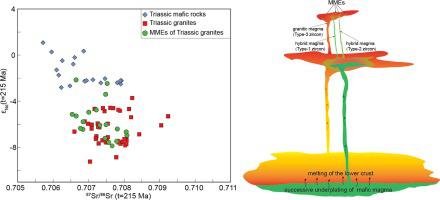Journal of Asian Earth Sciences ( IF 2.7 ) Pub Date : 2021-01-09 , DOI: 10.1016/j.jseaes.2020.104656 Jingzhao Dou , Xiguang Huang , Fukun Chen

|
Extensive Mesozoic magmatism in the Qinling orogenic belt, Central China, has produced voluminous granitic plutons. In Western Qinling, the Triassic Mishuling pluton contains abundant mafic microgranular enclaves (MMEs), recording magma mixing processes in the generation of the pluton. The Mishuling pluton is composed of quartz monzonite, whereas the MMEs are mainly diorite and monzonite. In this study, zircons from the MMEs are all dated by LA-ICP-MS at ca. 215 Ma, clearly consistent with the crystallization age of the host pluton. Quartz monzonites have low Mg# (43–48), Cr (30–64 ppm), and Ni (11–39 ppm) and high Th/U relative to the MMEs. Quartz monzonites are considered to have been produced by melting of Neoproterozoic mafic rocks in the northwestern part of the Yangtze Block, whereas the MMEs were likely the products of mixed mafic and felsic magmas. The mafic magmas may have been derived from partial melting of the enriched lithospheric mantle. Both the MMEs and host quartz monzonites have nearly identical Sr-Nd isotopic compositions, indicating that the hybrid melts and felsic magmas may have reached Sr-Nd isotopic equilibrium due to magma mixing. Zircon grains from the MMEs can be further divided into three types on the basis of internal texture and εHf(t). Overall, all these types of zircon grains have Th/U ranging from 0.18 to 1.63, typical of magmatic origin. Type-1 zircon grains show well-developed {1 0 0} and {1 1 0} prisms as well as {1 0 1} and {2 1 1} pyramids, whereas Type-2 zircon grains show well-developed {1 0 1} pyramids and {1 1 0} prisms. Types-1 and 2 zircon grains have slightly higher εHf(t) (–0.2 to –4.4) than those of the zircon grains from quartz monzonites (εHf(t) = –2.7 to –5.4), indicating crystallization from different hybrid magmas. Type-3 zircon grains have morphology and εHf(t) similar to and Hf concentrations lower than those of the zircon grains from quartz monzonites. We interpret that the Type-3 zircon grains were likely captured from less evolved granitic magmas and are thus xenocrysts in the MMEs. Therefore, the three types of zircon grains from the MMEs record successive magma mixing processes in deep-seated magma chambers. Such a scenario may have broad implications for magma mixing in the generation of granitic plutons.











































 京公网安备 11010802027423号
京公网安备 11010802027423号